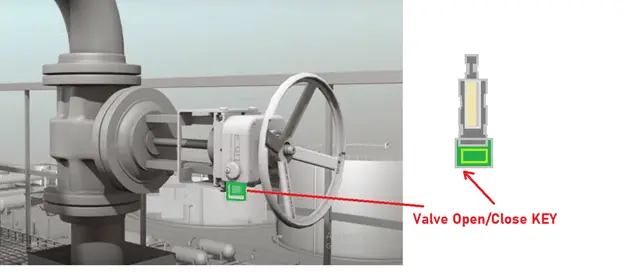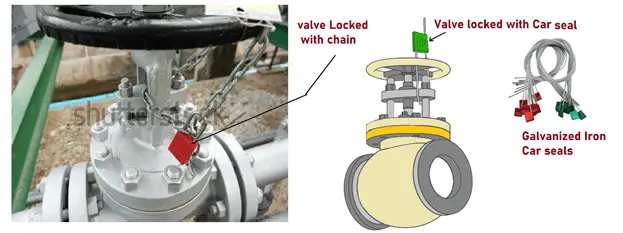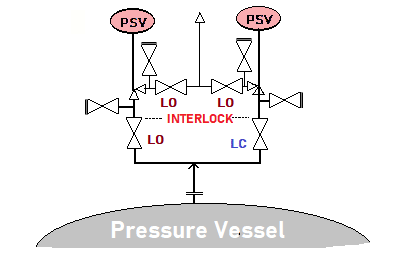In a valve, the abbreviation LO and LC are for locked open(LO) and locked close(LC) Valves respectively. These abbreviations have common use in plant documentation. Depending on a particular application, the valve may be Ball, Butterfly, Gate, Globe, or any other type.
A locked valve in process industries is identified during the project design stage as essential to the facility’s safety and integrity.
A valve can be locked open or locked close in various ways. It is shown in the figures below, it may be either by a
- Chain and lock
- Car seal
- Advanced design valves with the key arrangement

Vendors often include a locking device as part of their scope of supply when specifying process isolation valves. Alternatively, a cleat can be on the body of the valve through which a chain or D-link may be inserted, or a plate with drilled hole can be used to arrange the lock facility.
On Process Flow Diagrams (PFDs) or Process and Instrumentation Diagrams (P&IDs) and other related documentation, this type of locking arrangement is identified as LO (Locked Open) and LO (Locked Open).
A locked open or a locked closed valve state prevents pressure safety relief lines (PSV) or liquid drain lines from being accidentally operated.
A valve function can only be changed by authorized personnel known as “key personnel”. This is the preferred method of protection of the plant employing locked open or locked closed to this day.
Advantages of Locked Open (LO) and Locked Closed (LC) valves
In the chemical, oil & gas industry, it is common to use locked open or locked closed (LO or LC) valves for safety reasons. During normal operation, this arrangement ensures that certain critical manual valves remain in their intended positions. They are not operated intentionally. To manage the position of the valves and their lock in such a system, strict procedures need to be framed to avoid any kind of eventuality.
As a result, the organizations will develop a strong safety culture to safeguard equipment and personnel from the dangers of accidents.
Mechanical locking of Valves

The figure shown above is the tying with a chain and locking procedure used in the olden days. It consists of a piece of hard metal plate that can be fitted with a chain and lock to all hand-operated manual valves. To prevent the possibility of sabotage, a more sophisticated locking method became more important. As a result of these concerns, the mechanical interlocking system was developed for hand-operated, pneumatic, or electrically actuated valves.
The valve consists integral lock with a key arrangement. Keys are used to open or close the valve as per the necessity and are kept in the control room’s key cabinet. This cabinet can be accessible to only authorized key personnel.
A valve with locked open or closed operation can be performed in an individual or sequential manner. PIG launchers/ PIG receiver systems in the oil and gas industry are examples of sequence locking procedures. The PIG launcher/receiver system consists of several valves and each valve is assigned with a separately designated key.

Considering the safety of operational plant and personnel, locked open (LO) and Locked closed (LC) can be implemented in many types. Process hazard and operability (HAZOP) study is one tool to implement the valve locking system.
In the above image, two pressure safety valves (PSVs) are mounted to release the pressure of the vessel. One safety valve is always in line to avoid over-pressurization of the vessel. Implementation of interlock of locked open and locked valve arrangement can be seen.
Locked Open
Pressure vessels are fitted with pressure safety valves (PSVs) with locked open (LO) valves on the inlet and the outlet. A locked open valve is an isolation valve on the inlet and outlet of the PSV that must remain open during normal operation to protect the attached equipment.
It would be catastrophic if those valves were accidentally closed or unintentionally closed during normal operation. Therefore, they must be locked into their open position.
Locked Closed
An example would be a valve in a locked closed (LC) on the maintenance closed drains system. it is hazardous to enter hydrocarbons into the maintenance closed drains system during normal operation. As a result, the isolation valve on the drain line must be closed during normal operation.
A locked status of valves in a process plant must be maintained in the appropriate register. Auditing of LC and LO status varies from organization to organization. Few organizations do it every month and few for every quarter.
A permit to work (PTW) system procedure needs authorization when changing the normal state of a valve.